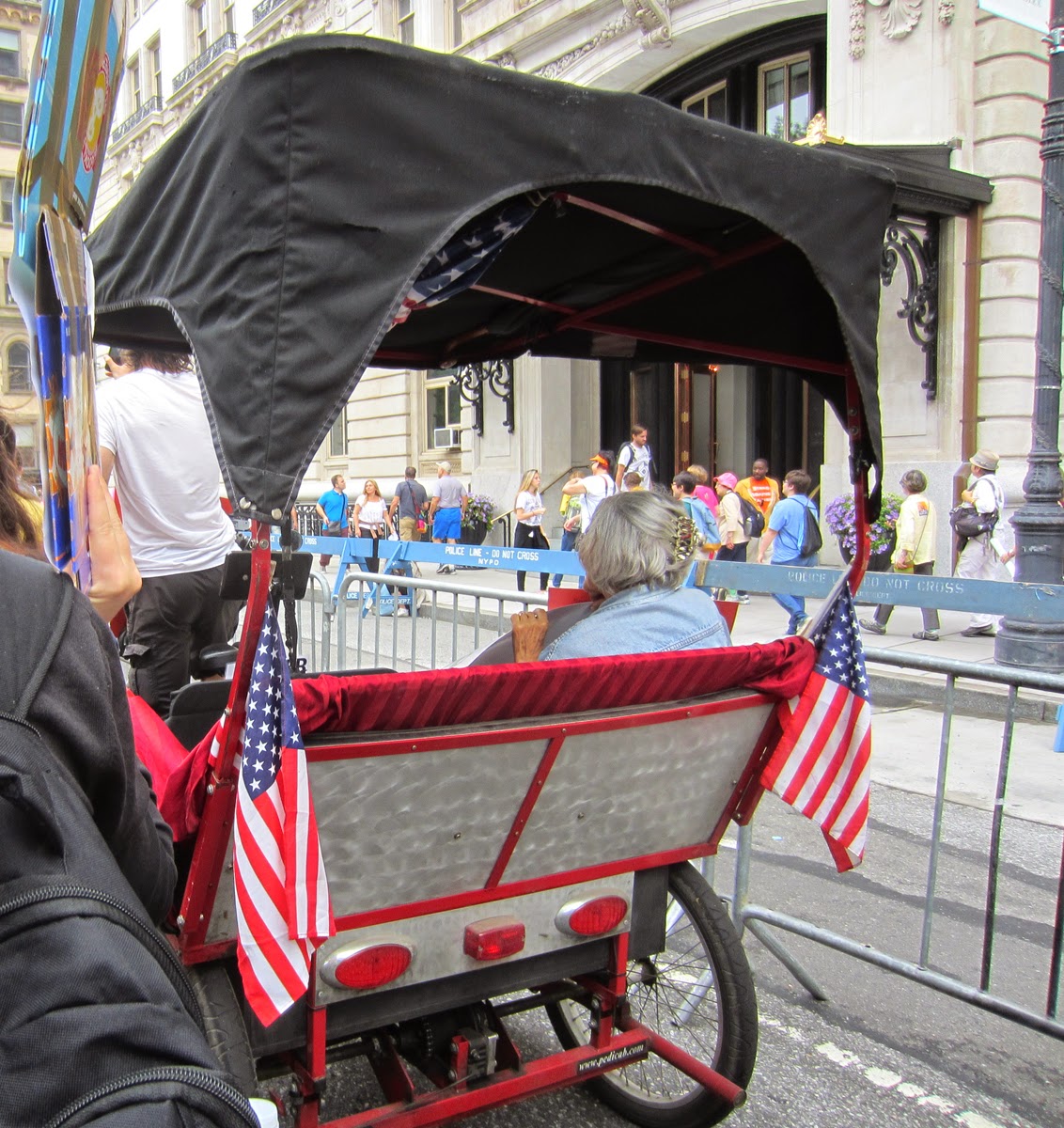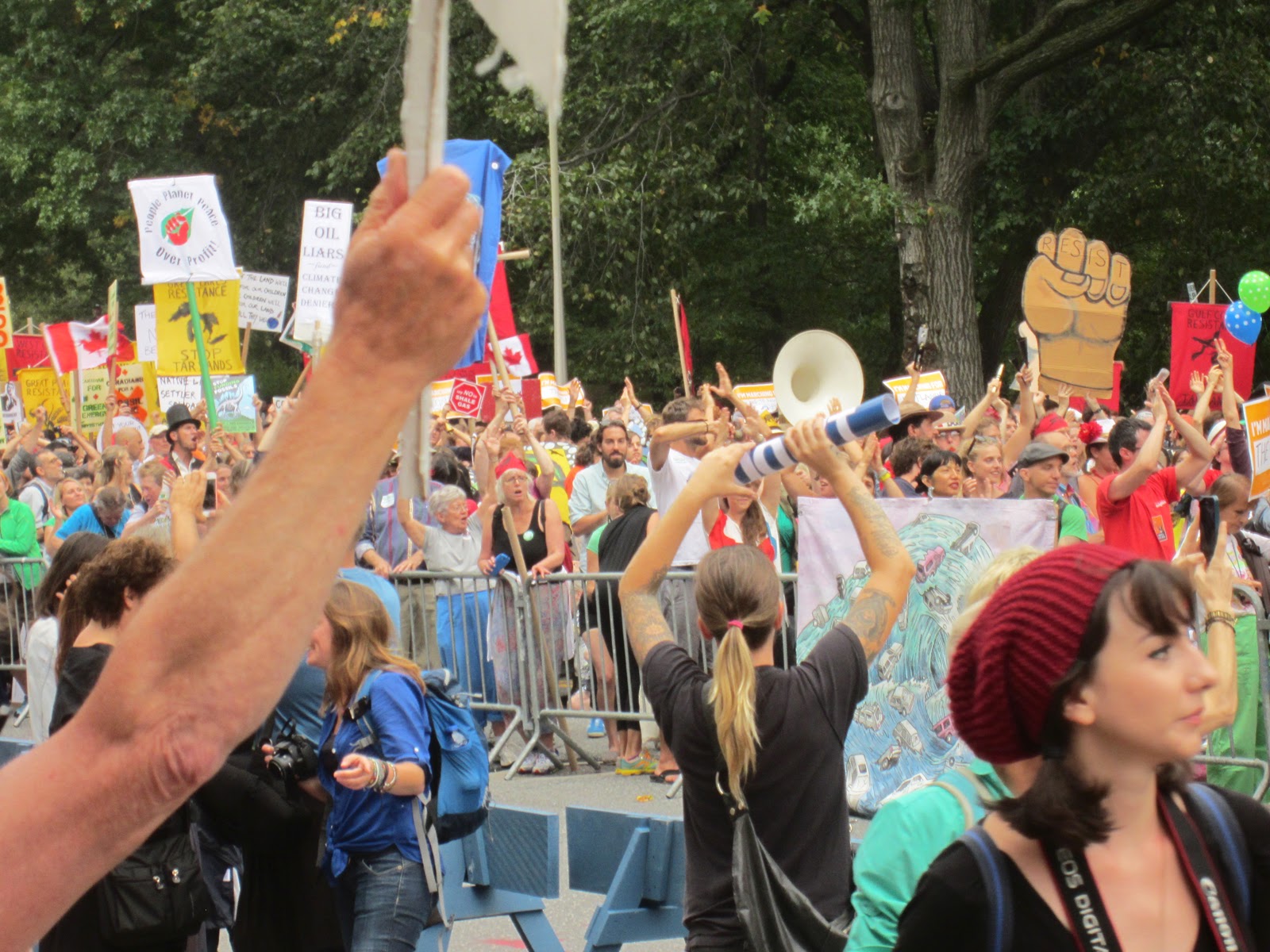49 leading environmental activists from all over the world
convened at Cooper Union for a two-day Teach-In conference this weekend on
Techno-Utopianism & the Fate of the Earth; why Technology will not Save the
World, presented by the International Forum on Globalization and the
Techno-Utopia Project in collaboration with the International Center for
Technology Assessment, the New York Open Center and the Schumacher Center for
New Economics.
 |
| Ralph Nader telling the overwhelmingly progressive audience to get over the "euwww" factor and make coalitions with Republicans to save the world from the Koch Brothers and the fossil fuel industries. |
Throuout the two days, they reminded us that revolutions
start and even are carried out by a handful of people. Tho the reality is grim,
we have the means to resist. The first act of resistance will be to get out the
vote in the USA next week, despite the feelings of learned helplessness in the
electorate. The changes they discussed in this event have all happened very
quickly, in the past ten years, and our time is short to forestall the worst
damage of what has been set in motion.
I took many notes and will add installments, links and
pictures to this post over the next few days, as I have time. First, I want to
just set it all down. I took the notes so fast that I’m not sure I always got
the precise quote or the attribution so apologize for that. It will need to be
better organized later.
The general message was that corporations have bought
governments internationally, and especially, in the United States, where the
Koch Bros have bought most Universities, the US Congress and are about to buy
the Senate. However, there is a vigorous resistance movement led by Indigenous
Peoples and young organic farmers. The goal of the Koch Bros and their cohorts
is a state of perpetual global nuclear war fueled by conscienceless extractive
industries, manned increasingly by intelligent robots and enslaved and
indentured human labor, thanks to vast over-population. Science fiction horror
story? Not anymore.
 |
| Some of the many books on sale outside the Cooper Union hall |
The antidote is accepting limitation, effecting structural
change, collaboration without ego, facing how addicted we are to the delusion
of cheap, easy, fast energy. We must come back to our bodies and the earth.
“Efficiency” only increases competition and alienation. Negative consequences
are inevitable (Barry Commoner). There are no techno fixes. Over-population is
the friend of business and religion (but not the earth). Over-population began
with agriculture, not the industrial revolution, when we got the idea we could
control nature. At the advent of agriculture, the human population exploded.
Everything has a cost. Progress is a process of diminishing returns. The
weakness of the scientific method is reductionism.
We now have market driven education. There was a time when
the UN had regulatory control over corporations, but pressure from the US gutted
those provisions.
 |
| Helen Callicott indicating where fall out from her Chernobl continues to poison people and habitat. |
Helen Callicott: Congress has now allocated $1 trillion to
new nuclear programs that even the Pentagon did not want. 1 million people died
from Chernobyl. Nothing should be eaten from Turkey or Japan because it is so
radioactive. Fukushima still releases 3-400 tons of radioactivity into the
Pacific Ocean daily. This is a crisis without end. The goal now is nuclear
power to explore space for mineral extractions by the military industrial
complex.
Wes Jackson: “technology shapes culture. Biodiversity
(should be) the metric for success. Efficiency is inherent in natural
integrities.”
“How to survive genocide (towards the goal of extractive
industries)?”
weapons of war have become the US’s primary industry. $.59
of every tax dollar goes towards the Pentagon. 10% of Maine’s economy is now
military and they plan to put missile sites and toxic fuel in the Rangeley
Mountains at a cost of $4 billion to benefit Boeing. The Chicago Crown family
is being “rewarded” by Obama for their support of his election with the
Rangeley contract. The Pentagon didn’t even want it. Not even Congress wanted it but Obama did.
Vandana Shiva: “We defended the freedom of the seeds.
Monsanto earned $10 billion from seed patenting in the US alone. They have
bought the biggest soil database. They are sueing seed libraries. In 2008,
Ghandi taught us not to obey bad laws. The propaganda for this corporate
biopiracy is being packaged as religion, referring to “miracle” seeds and
apostles.
GMOs are failures. They advertise results before they have
them and then can’t verify anything. Instead, indigenous yields are 10- 100
times what Monsanto can deliver. Monsanto delivers “food” commodities that
aren’t actually food. They measure “yield” but not nutrition. GMO agricultural
land produces 30% of food but destroys 70% of the earth’s biodiversity.”
Atossi Soltani on work in the Amazon: “Indigenous peoples
are the guardians of the earth. Their lands are the same lands where we find
80% of the earth’s biodiversity. 4% of the world’s population are protecting
that 80%. We must subvert the war paradigm that leads to deforestation. This
means being good to our ancestors. The most biodiverse lands are threatened
today by oil companies. When 800 000 Ecuadorans signed a petition to keep the
oil in the ground, but President Rafael Correo went back on his campaign
promises and over rode the petition.
Richard Feinberg: “the party (for us) is over. Adam Smith
warned us that applying supply and demand to nature is a recipe for disaster.
(But now) labor (humans), and land (nature), have all been commodified. EROEI:
energy return on energy investment. We need FRED: Facing the reality of
Extinction and Doom. Efficiency =
ideological displacement, cognitive belittlement and fictitious commodities
unless we can re-embed the economy in ecology and nature. Denial of limits
means the loss of beauty. (Because) we haven’t accepted limitation, the banks
have been allowed to get even bigger and more irresponsible. The coming crash
will be 10X worse than what we saw in 2008.
Quote from a Chinese GMO scientist: “we can now produce
anything, anywhere, without people.” This will mean the end of countless small
farmers world-wide, for example in Haiti where they produce vetiver for
perfumes or in Madagascar where they produce vanilla.
Anthropocentrism, arrogance, greed run amuck.
The question this begs is, without real education, jobs, or
governance, what will happen to the billions of useless, disenfranchised,
impoverished people of the world, let alone, the remaining wildlife?
Pat Mooney: “the rich see what’s coming. The poor can’t get
out of the way.”
We need:
1.
public education
2. exposure
3. strategy
Ralph Nader: “organize, organize with the right, organize.
The biggest asset these corporations have is to inculcate feelings of
powerlessness. How they have done this is:
1.
technological development
2.
secrecy
3.
alliance with the state
4.
buying time with a science backlash
5.
They have confused corporate science with
academic science
6.
They have compromised academic credibility in
Universities with “research” money
This is the golden age of exposure documentaries but the
missing link is distribution. The best films might reach 150 000. The best book
might reach 10 000.
The public must wake up, be woken up. Start small, in one
place, 1 congressional district. Organize with intensity, persistence. Change
the zeitgeist.
The prescription: clear thinking. (But) the public (seems)
bored with solutions.
(Is it) easier than we think? How much does it take to
effect change?”
Bill McKibben: “I (still) feel fear dominated by sadness.
‘We have become as gods, destroyers of the world.’ Restraint is a gift. The
climate change movement is conservative. The oil people are reckless
radicals.
This will be a
leaderless movement. We will be protean.”
 |
| Hans Haacke's commentary on the Koch Bros. "purchase" of the Metropolitan Museum of Art |
Personally, I felt devastated and physically
sick, as I had written on FB Saturday night, by the sheer scale of evil
ambition and ruthless exercise of financial power that was being detailed. I
also found myself thinking that the community appeal of the presenters would
not be met (at least among ecological artists, whom I think should be
spearheading a response) because the market forces on us still make ego and
competition too tempting distractions from what is required, which is grounded
in a profound generosity of spirit and vision- that little in art world
traditions fosters.
However, I do still think most of us can (and
should) be part of a significant movement. As I stressed, it just takes a few,
not all of us.
What the presenters spoke about that answers
spiritual questions on Sunday, was the sheer faith in that possibility of the
power of the small and few, not just in terms of activist organizing, but the
very personal capacity of humans to rise to these challenges and how those few
people can turn a tide (what for me, represents what I term trigger points). I
think that is a profoundly spiritual position. I suppose I didn't write more
about it yesterday because it both seemed obvious to me and I was still reeling
from much of what I'd heard and been thinking about.
Finally, Sunday, which is what I will write
more about asap, was all about models of incredible courage and beauty, mostly,
as I wrote before, from Indigenous and young people. In the case of the former,
the spiritual was explicit in many forms and deeply inspiring, even cathartic
to hear.
A theme that emerged at the conference Sunday, was that property-based laws that protect corporate banditry are unjust, must be resisted and fought, just as people fought for slave emancipation and suffrage. That analogy was repeatedly made and framed as the "integrity of whole communities," including whole rivers, etc. Winona LaDuke & a woman from the Amazon were amazing on this topic. That is what I will write about next.








































